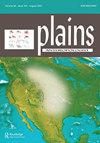Riding to the rescue: an addition to the Plains Biographic rock art lexicon
Q2 Social Sciences
引用次数: 0
Abstract
Depictions of two riders mounted on a single horse appear in Plains Biographic rock art at five sites. Comparison of these images with late nineteenth century Plains Indian drawings on hide and paper indicates that the pictographs and petroglyphs commemorate instances in which mounted warriors rescued comrades who had been unhorsed in battle. Ethnographic material confirms that several Plains Indian societies held this deed in high esteem. These societies employed formal mechanisms for recognizing individuals who had rescued comrades. While the importance of martial themes in Plains Biographic rock art has been widely acknowledged, emphasis has been placed on the acts of counting coup, capturing weapons, and taking horses. The identification of depictions of two warriors on a single horse as rescue scenes adds to our understanding of the diversity of martial exploits recognized by Plains Indian societies.骑马去救援:平原传记岩石艺术词典的补充
两名骑手骑在一匹马的描绘出现在平原传记岩石艺术在五个地点。将这些图像与19世纪晚期平原印第安人在兽皮和纸上绘制的图像进行比较,可以发现这些象形文字和岩画是为了纪念骑马的战士在战斗中救出被下马的战友。人种学资料证实,几个平原印第安人社会高度尊重这一行为。这些社团采用正式的机制来表彰那些拯救了同志的个人。虽然平原传记岩石艺术中军事主题的重要性已得到广泛认可,但重点放在计数政变,夺取武器和夺取马匹的行为上。两名战士骑在一匹马上作为救援场景的描述,增加了我们对平原印第安社会所认可的军事壮举多样性的理解。
本文章由计算机程序翻译,如有差异,请以英文原文为准。
求助全文
约1分钟内获得全文
求助全文

 求助内容:
求助内容: 应助结果提醒方式:
应助结果提醒方式:


